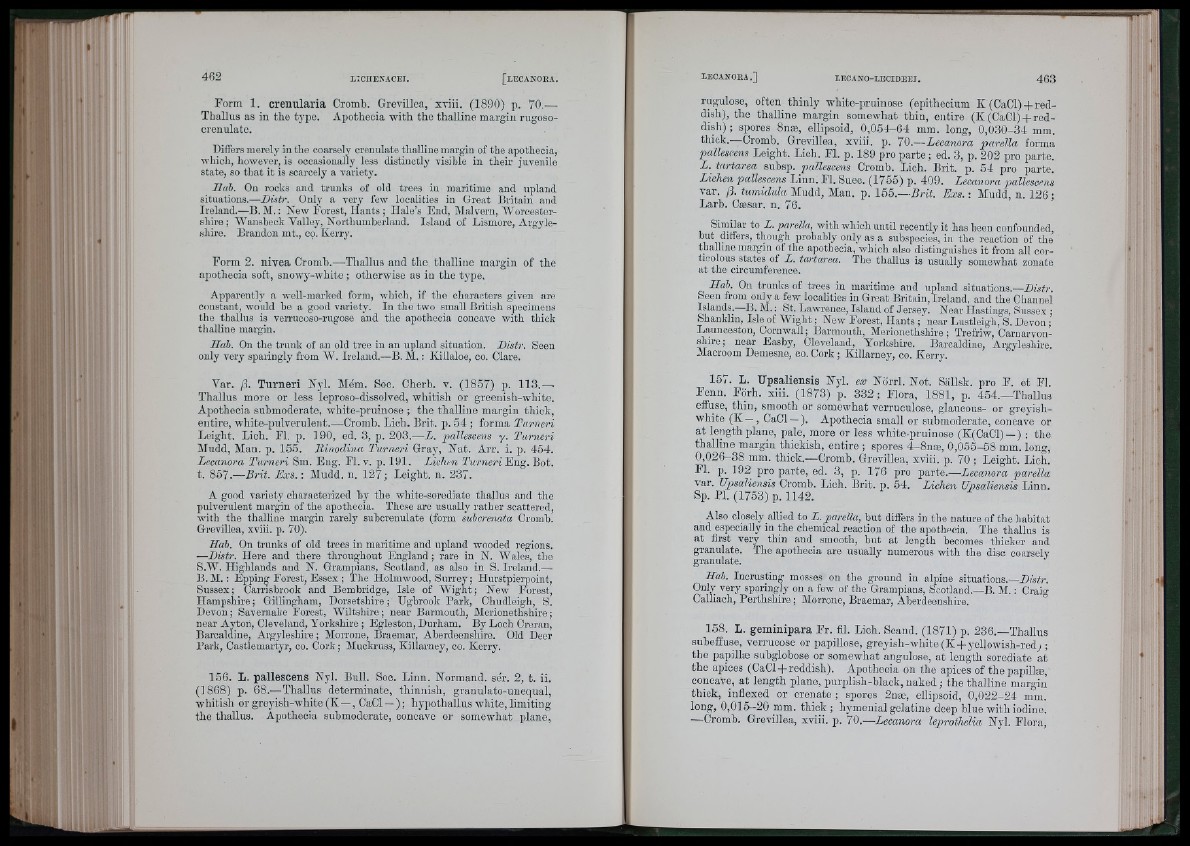
Form 1. creniilaria Cromb. Grovilloa, xviii. (1890) p. 70.—
Thallus as in tho type. Apotheoia w ith the thalline margin rugoso-
crenulato.
Differs merely in the coarsely crenulate thalline inargin of the apothecia,
which, however, is occasionally less distinctly visible iu their juvenile
state, so th at it is scarcely a variety.
Ilah. On rocks and trunks of old trees in maritime and upland
situations.—Distr. Only a very few localities in Great Britain and
Ireland.—B.M. : Kew ï'orest, Hants ; Hale’s End, Alalvern, AVorcestershire
; AA'ansbeck Valley, Nortlmmberlaud. Island of Lismore, Argyleshire.
Brandon mt., co. Kerry.
Form 2. nivea Cromb.—Thallus and th e th allin e margin of tho
apothecia soft, snowy-whito ; otherwise as in th e type.
Apparently a well-marked form, wdiich, if the characters given are
constant, would he a good variety. In the two small British specimens
the thallus is veiTUCoso-rugose and the apothecia concave with thick
thalline margin.
Hah. On the trunk of an old tree in an upland situation. Distr. Seeu
only very sparingly from AV. Ireland.—B. Al. : Killaloe, co. Clare.
A'ar. ¡3. Turneri Nyl. Mém. Soo. Cherb. v. (1857) p. 1 1 3 .—
Thallus more or less leproso-dissolved, whitish or greenish-wliito.
Apotheoia submoderate, white-pruinose ; th e th alliu e margin thick,
entire, white-pulverulent.—Cromb. Lioh. Brit. p. 54 ; forma Turneri
Leight. Lioh. Fl. p. 190, ed. 3, p. 203.—L. pallescens y. Turneri
Mudd, Alan. p. 155. Bin o d in a Turneri Gray, Nat. Arr. i. p. 454.
Lecanora Turneri Sm. Eug. F l. v. p. 191. Lichen Turneri Eng. Bot.
t. 857.—B rit. E xs. : Mudd. n. 127 ; Loight. n. 237.
A good variety characterized by the white-sorediate thallus and the
pulverulent margin of the apothecia. These are usually rather scattered,
with the thalliue margin rarely suhcrenulate (form suhcrenata Cromh.
Grevillea, xviii. p. 70).
Hab. On trunks of old trees in maritime and upland wooded regions.
—Distr. Here and there throughout England; rare iu N. AVales, the
S.AA'. Highlands aud N. Grampians, Scotland, as also in S. Ireland.—
B.AI.: Epping Forest, Essex ; The Holmwood, Surrey; Hurstpierpoint,
Sussex; Carrisbrook and Bembridge, Isle of AVight; New Forest,
Hampshire ; Gillingham, Dorsetshire ; Ughrook Park, Chudleigh, S.
Devon; Savernake Forest, AViltshire; near Barmouth, Alerionethshire;
near Ayton, Cleveland, York.shire ; Egleston, Durham. By Loch Creran,
Barealdine, Argyleshire ; Alorroue, Braemar, Aberdeenshire. Old Deer
Park, Castlemartyr, co. Cork ; Aluekruss, Killarney, co. Kerry.
156. L. pallescens Nyl. Bull. Soo. Linn. Normand, sér. 2, t. ii.
(1868) p. 68.'—Thallus determinate, thinnish, granulato-unequal,
whitish or greyish-white (K — , CaCl —); hypothallus white, limiting
the thallus. Apotheoia submoderate, oonoavo or somewhat piano,
rugulose, often th in ly white-pruinose (epitheoium K (CaCl) + reddish),
the thalline margin somewhat th in , eutire (K (CaCl) + red-
d i j ) ; spores 8næ, ellipsoid, 0 ,0 5 4 -6 4 mm. long, 0 ,0 3 0 -3 4 mm.
thick. Cromb. Grevillea, xviii. p. 70.— Lecanora p arella forma
pallescens Leight. Lioh. F l. p. 189 pro p a rte ; od. 3, p. 202 pro parte.
L . tartarea subsp. pallescens Cromb. Lich. Brit. p. 54 pro parte.
Lichen pallescens Linn. Fl. Sueo. (1755) p. 409. Lecanora pallescens
var. (3. tumidula Aludd, Man. p. 155.—B rit. Exs. : Mudd, n. 126 ;
Larb. Cæsar. n. 76.
Similar to L. parella, with which until recently it has been confounded,
uut diners, though probably only as a subspecies, in the reaction of the
thalline margin o fth e apothecia, ivhich also distinguishes it from all corticolous
states of L. tartarea. The thallus is usually somewhat zonate
at the circumference.
Hah. On trunks of trees in maritime and upland situations.—D h tr.
Seen from only a few localities iu Great Britain, Ireland, and the Channel
Islands. B. M. : St. Lawrence, Island of Jersey. Near Hastings, Susse.x :
Shanklin, Isle of Wight ; New Forest, Hants ; near Lustleigh, S. Devon ;
Launceston, Oornwall; Barmouth, Merionethshire; Trefriw, Carnarvonshire;
near Easby, Cleveland,^ Yorkshire. Barcaldine, Aro-yleshire.
Macroom Demesne, co. Cork ; Killarney, co. Kerry. ^
157. L. Upsaliensis Nyl. ex Norrl. Not. Siillsk. pro F . ot FI.
Fen n . Fiirh. xiii. (1873) p. 3 3 2 ; Flora, 1881, p. 454.—Thallus
effuse, th in , smooth or somewhat verruculose, glaucous- or greyish-
white (K —, CaCl — ). Apotheoia small or submoderate, concavo or
a t length plane, pale, more or less white-pruinose (K(CaCl) —) ; tho
th allin e margin thickish, entire ; sporos 4 -8 næ , 0 ,0 5 5 -5 8 mm. long,
0,026—38 mm. thiok.—Cromb. Grevillea, xviii. p. 70 ; Leight. Lich.
F l. p. 192 pro parte, ed. 3, p. 176 pro p a rte .—Lecanora parella
var. Upsaliensis Cromb. Lich. Brit. p. 64. Lichen Upsaliensis Linn.
Sp. PL (1753) p. 1142.
Also closely allied to L. parella, hut differs in the nature of the iiabitat
aud especially in the chemical reaction of the apotlmcia. The thallus is
a t first very thin and smooth, but at length becomes thicker and
granulate. The apothecia are usually numerous with the disc coarsely
granulate.
Hab. Incrusting mosses ou the ground in alpine situations.—Distr.
Only very sparingly on a few of the Grampians, Scotland.—B. AI. : Craig
Calliach, Perthshire ; Alorrone, Braemar, Aberdeeushire.
158. L. geminipara F r. fil. Lioh. Scand. (1871) p. 236.—Thallus
subeffuse, verruoose or papillose, g re y ish -w h ite (K +yellowish -red ; ;
th e papillæ subglobose or somewhat angulose, a t length sorediate a t
th e apices (CaCl + reddish). Apotheoia on tho apices of th e papillae,
concave, a t length plane, purplish-black, naked ; the thalline margin
thick, inflexed or crenate ; spores 2næ, ellipsoid, 0 ,0 2 2 -2 4 mm.
long, 0,015—20 mm. th io k ; h j’menial gelatine deep blue with iodine.
— Cromh. Grevillea, xviii. p. 70.— Lecanora leprothelia Nyl. Flora,